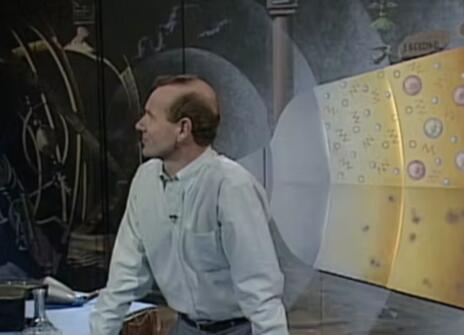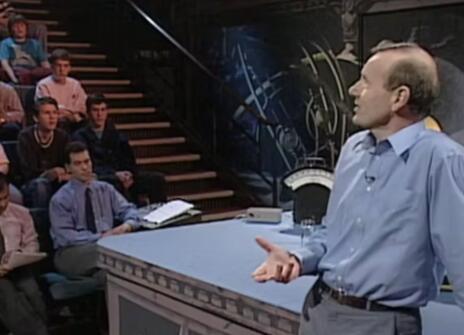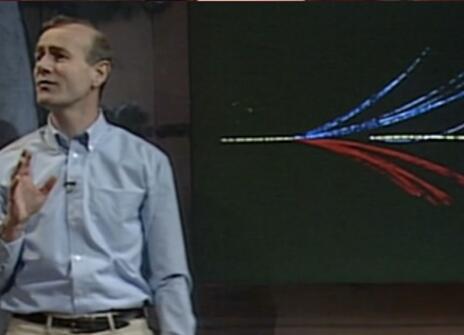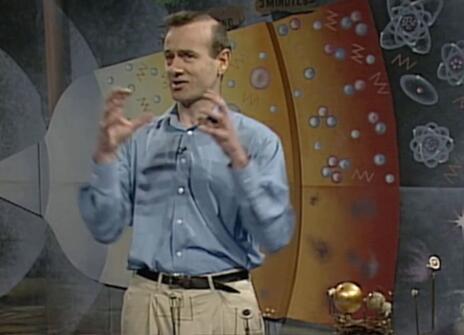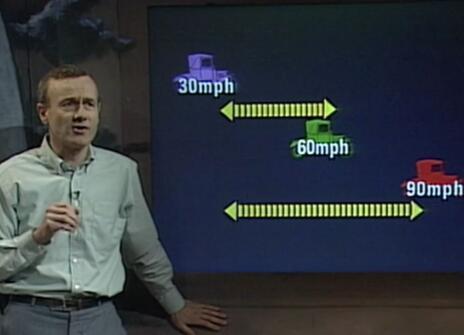Lecture 2 – To the centre of the sun
From the 1993 lecture programme:
The big bang, happened 20 billion years ago. Over 100,000 years elapsed before the Universe was cool enough for atoms to survive; their seeds – the atomic nucleus – were cooked in stars, but the simplest examples were already formed within about 3 minutes of the big bang. Much of what we see happening around us day by day at home and at work involves atoms and molecules – the stuff of biology and chemistry. Moreover, the stars, such as the sun, are nuclear physics in operation – their central heat is like the Universe when only a few minutes old.
The first signs of the atomic nucleus come with radioactivity. Everything is radioactive to a greater or lesser extent. You can hear radioactivity by means of Geiger counters; you can see its radiation by means of a cloud chamber, or by the dark trails when a speck of radium is dropped onto a photographic emulsion.
We can photograph nuclear collisions and nuclear transmutation by means of a cloud chamber and see how to 'weigh' the nuclei of different elements by means of atomic billiards. Many nuclei are magnetic and send out radio signals. This 'nuclear magnetic resonance' can be used to produce images of the brain at work.
By learning about atomic nuclei, how they behave, form and change, we begin to understand how the stars and, in particular, our sun produce their power.
About the 1993 CHRISTMAS LECTURES
In our 1993 CHRISTMAS LECTURES, particle physicist Frank Close OBE looks at how our understanding of particle physics developed over the 20th century.
From the 1993 Lecture programme:
The lectures will trace a hundred years of discovery and invention, culminating with a look into the crystal ball towards the next century. The developing story begins in 1893, when the Royal Institution lecturer inhabits a world ignorant of radioactivity, electrons and the working of atoms, knowing nothing of how stars shine, nor of galaxies let alone that they are rushing outwards from a primeval big bang.
Even so, scientists were confident that they were on the brink of describing all basic natural phenomena. Fundamental discoveries at the turn of the century changed all that. Hints that “all was not well” turned out to be true and revolutionary rather than requiring tinkering with a few ideas.
A century later, in 1993, one hears talk of a 'Theory of Everything' and there is debate as to whether we can 'know the mind of God'. Yet even now there are hints that 'all is not well'. The lectures will bring us to the current frontier and try to learn from the experiences of the intervening century of discovery and controversy.
The theme will show how discoveries of natural phenomena provide new tools that, in turn, open up new areas of research leading to further insights, innovation and technologies. The developments feedback, creating new opportunities which often are far removed from the original discovery. The net result is that we are continually extending and deepening our experiences of Nature beyond those accessible to our five senses.
Our five senses reveal the beauty of the everyday world, enabling us to look out to nearby stars, to focus on objects as small as the width of a human hair and to react to events as brief as 1/25th of a second. Many other animals have sharper senses than ours but our ingenuity and inventiveness in effect extend our senses with telescopes, microscopes and other sophisticated tools. Thus it is our 'sixth sense' that expands our watch on the Universe, reveals images deep within individual atoms and discovers Nature at work on timescales of less than a microsecond.
Telescopes on satellites above the atmosphere capture light that was born when the galaxies first formed. Experiments in high energy particle accelerators on Earth teach us how to decode these messages that reveal our origins: we are looking back to (nearly) the Big Bang.
At another extreme we can photograph and display the entire life of a single subatomic particle lasting a mere thousand millionth of a second – an essential part of Nature’s scheme but hidden from our five senses. As hieroglyphics contained the secrets of the Pharaohs, so do these modern pictographs from CERN begin to reveal the story of creation. Not only can we see how the stuff of the present Universe was formed, we also have clues to its possible fate.
